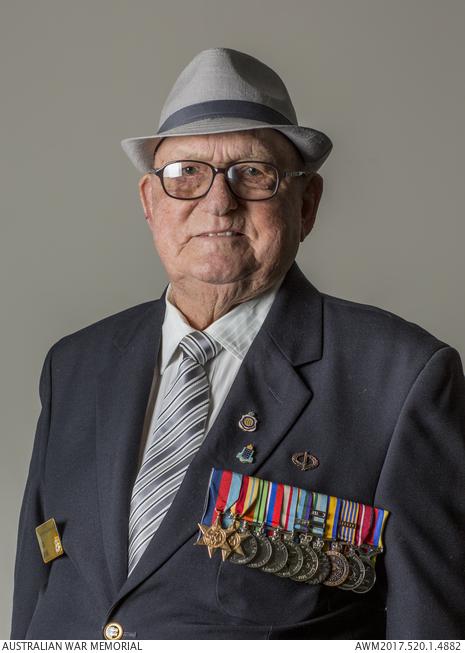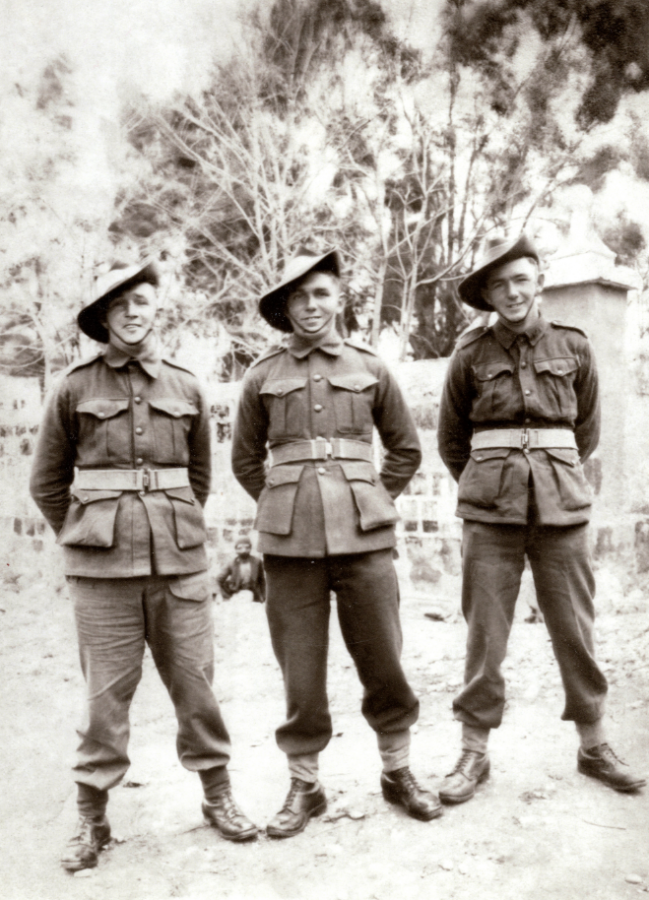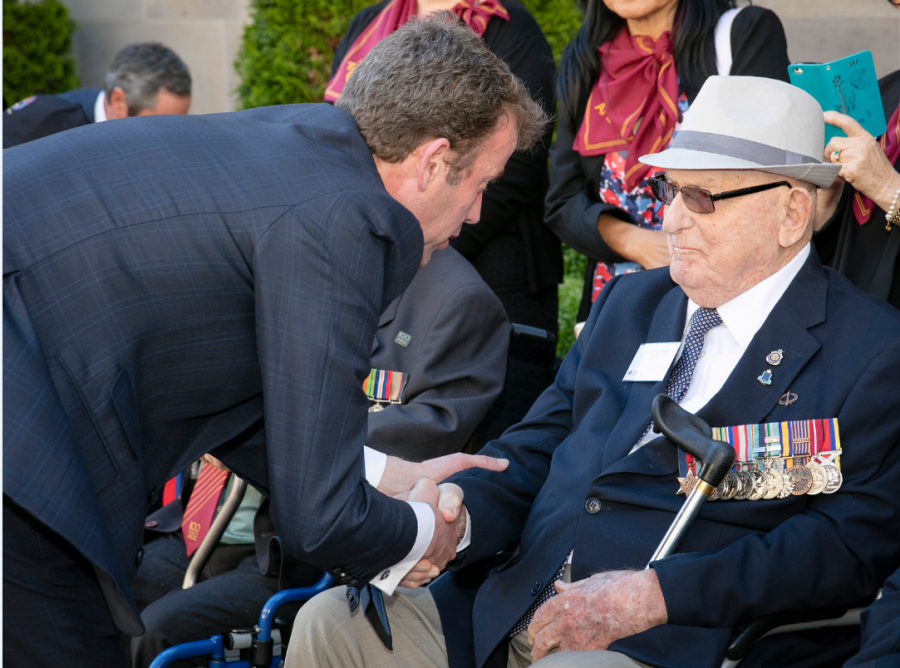'How do you describe a place like that?'

Second World War veteran Sydney Shaw: "The Germans counter attacked and they captured all of us."
Sydney Shaw will never forget the day he made it to Switzerland after escaping from a prisoner of war camp in northern Italy during the Second World War.
“In September of ’43, we were out working … and the Italians capitulated, so we took off,” Shaw said.
“Some of the boys went down south, but it was too far to go and you had to go through the German lines, so we went to Switzerland and we ended up having to go through the Alps.
“And getting into Switzerland, [you had to go over] 12,000-foot bloody mountains, and when we got up the top one, the cloud come down and we were lost. Our guides had taken off, because they were the first ones shot as smugglers, so we just had to sit out there amongst the rocks for the night.
“The next morning, [it was] a sunny morning and [there was] a big patch of snow where they indicated … we should go.
“We clambered forward, got up the top, and there was the bell and all that and we were in Switzerland.”
Shaw – who turns 95 next month – was one of 23 veterans who visited the Australian War Memorial to commemorate the 75th anniversary of the battle of El Alamein.
He grew up in Perth and was working as a butcher when the Second World War broke out.
Spurred by a sense of patriotism and a sense of adventure, Shaw enlisted in May 1941 joining the infantry. “I had two brothers who were in the forces and I went in with them,” he said. “I was a young bloke. I was just 18.”

Sydney Shaw, centre, with his brothers Bob and Roy, all of the 2/32nd battalion, in Beirut in 1942. Bob was hit by shrapnel at El Alamein in July 1942 and Roy was hit in the leg during the second battle in October 1942.
After training in Australia and six months in Lebanon, Shaw arrived in Egypt with the 2/32nd Infantry Battalion for the battle of El Alamein. Named after a tiny railway stop in Egypt’s Western Desert, the battle of El Alamein proved to be a turning point in the war in North Africa. It was during the July attacks that Shaw was taken prisoner.
“It was pretty rugged in them days,” Shaw said. “We did two attacks in the beginning of July in 1942, and both times we took our target, and got pushed off, and there were counter attacks.
“One of my brothers [Bob] got hit through the head by an 88mm piece of shrapnel, [but] he survived. He would have been 21.
“And then on the 22nd of July we did another attack against the Germans.
“[It was] the same thing, we got into position, [but] we got lost in the fog and the smoke – the smokescreen that was put down – and the Germans counter attacked and they captured all of us.
“We just got over run by the Germans. They had big tanks charging down on top of us, and we were promised tanks and that when we got into position, but we never saw them – they never turned up. They just left us to our own devices and we all got captured – killed or captured.”
Shaw was one of several hundred who were taken prisoner and taken to Benghazi before being loaded onto an Italian cargo ship destined for a prisoner of war camp in Italy.
“Day by day we moved back until we finished up in Benghazi, which was a stinking hell hole,” Shaw said.
“There were thousands of people. Both sides used it – the Germans used it when they were in charge of Benghazi and the British used it when they were in charge of it. [But] it was a shocking place, full of fleas and lice.”
Shaw was one of 3,200 Allied prisoners of war aboard the MV Nino Bixio when it came under fire from the British Submarine HMS Turbulent in August 1942.
“We got across the Mediterranean and at half past four on the 17th a British submarine put two torpedoes into it,” Shaw said.
“The first torpedo exploded in our hold … I was knocked unconscious. I don’t know how long I was unconscious for, but they tell me the Italian destroyers dropped death charges. I never heard a thing, so I must have been out for quite a while.
“Eventually, I was the only one down there [in the hold] – everyone was gone, or they were dead, or whatever. I got up on the top deck and the Italian captain was running around with a big Luger trying to tell everyone not to jump … because everyone was jumping overboard thinking it was going to sink.
“They did an almighty job and then it got towed [by the Italian Freccia-class destroyer Saetta] into Port Navarino in Greece. We were there for about a fortnight and then they took us across to Italy and we went into a normal prisoner of war camp in those days.”

Sydney Shaw visiting the Second World War galleries at the Memorial.
Shaw spent a year being transferred across numerous Italian prisoner of war camps before being sent to Italian work camp P.G. 106 in the north in July 1943.
“How do you describe a place like that!?” he said.
“You’re continually hungry, full of lice. All your clothing, you had lice eggs. We used to sit and take our jackets off and crack the whole lice if we could …
“Every now and again they’d give you a hot bath and dry clean your clothing, but the dry cleaning wasn’t hot enough, so what eggs were there used to hatch and you’d get your clothing back and it would be twice as bad. So every time we went for a hot shower, month to month, we wouldn’t put our clothes out. They’d be fat with lice.”
The prisoners slept on hessian mattresses in cramped bunks and were so cold they would sit on top of the hot belly stove to keep warm.
One time the prisoners found the start of an escape route. “A tunnel had already been dug,” Shaw said. “They’d started it, and 30-odd blokes tried to escape, but they were all captured.”
Later, Shaw and a group of others made their daring escape across northern Italy and the Alps. The Allies had launched their invasion of Italy on 3 September, and the prisoners had taken the opportunity when they saw it.
“[At first] they were too busy trying to apprehend the landing down south and getting their troops down south, that they weren’t worried too much,” Shaw said. “And then they got fair dinkum about chasing everyone. The Italians had deserted, and they pulled them back and they changed the rationing and all that, so you didn’t have the proper rations.
“They didn’t want to fight with the Germans, so they left us to our own devices, so away we went.
“Listening to whatever bit of news we got, we decided to head to Switzerland … because they would receive us as escaped prisoners of war.
“Along the way … the Italian peasants … fed us. I’ve never eaten so much frog cooked up with bloody rice.
“Thirteen days it took us to do about 80-odd kilometres. We mainly moved by night. We didn’t move by day because the Germans would be out scouting around on motorbikes, so if you got on a main road, you could bet your bottom dollar, you’d either get shot or captured, so we’d just kept off the main road.”
He will always remember his first glimpse of Switzerland, knowing that they were finally safe.
“[We were] excited,” he said. “That’s where we were aiming for because we didn’t want to be captured again. The Italian militia was very active up there. They would sort of shoot to kill and ask questions afterwards, but we never saw any of them.
“Thirteen of us started out, two pulled out, and 11 of us got in. But there were about 400 Australians and new Zealanders in Switzerland. [It’s a] neutral country and we were well treated. The British Consul was operating and they looked after us.”
After the war, Shaw worked at an electrical and gas department before re-enlisting in the Regular Army in 1947. “I went all round the place – a couple of years in Malaya, a couple of years in Port Moresby … a couple of years in SAS,” he said. “I had about 32 years in the military – it was a good stint.”

Sydney Shaw at the Memorial during commemorations marking the 75th anniversary of the battle of El Alamein.